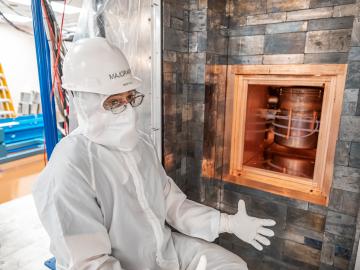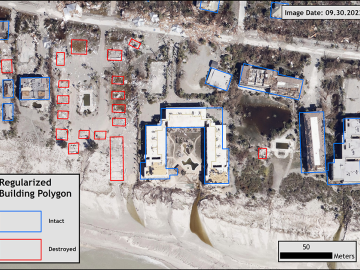
Filter News
Area of Research
- (-) Materials (72)
- (-) National Security (34)
- (-) Nuclear Science and Technology (4)
- (-) Supercomputing (66)
- Advanced Manufacturing (6)
- Biology and Environment (95)
- Building Technologies (2)
- Computational Biology (2)
- Computational Engineering (1)
- Computer Science (9)
- Electricity and Smart Grid (1)
- Energy Science (92)
- Energy Sciences (1)
- Functional Materials for Energy (1)
- Fusion and Fission (8)
- Fusion Energy (1)
- Materials for Computing (9)
- Neutron Science (23)
- Quantum information Science (4)
News Topics
- (-) Artificial Intelligence (48)
- (-) Biology (17)
- (-) Cybersecurity (23)
- (-) Microscopy (29)
- (-) Physics (36)
- 3-D Printing/Advanced Manufacturing (30)
- Advanced Reactors (16)
- Big Data (25)
- Bioenergy (20)
- Biomedical (23)
- Biotechnology (3)
- Buildings (8)
- Chemical Sciences (32)
- Clean Water (3)
- Composites (9)
- Computer Science (109)
- Coronavirus (19)
- Critical Materials (15)
- Energy Storage (38)
- Environment (40)
- Exascale Computing (26)
- Frontier (32)
- Fusion (17)
- Grid (15)
- High-Performance Computing (47)
- Irradiation (1)
- Isotopes (17)
- ITER (1)
- Machine Learning (24)
- Materials (80)
- Materials Science (84)
- Mathematics (2)
- Molten Salt (7)
- Nanotechnology (42)
- National Security (36)
- Neutron Science (47)
- Nuclear Energy (55)
- Partnerships (15)
- Polymers (18)
- Quantum Computing (21)
- Quantum Science (34)
- Security (15)
- Simulation (16)
- Software (1)
- Space Exploration (10)
- Summit (43)
- Transportation (21)
Media Contacts

For nearly six years, the Majorana Demonstrator quietly listened to the universe. Nearly a mile underground at the Sanford Underground Research Facility, or SURF, in Lead, South Dakota, the experiment collected data that could answer one of the most perplexing questions in physics: Why is the universe filled with something instead of nothing?

U2opia Technology, a consortium of technology and administrative executives with extensive experience in both industry and defense, has exclusively licensed two technologies from ORNL that offer a new method for advanced cybersecurity monitoring in real time.

Scientists at the Department of Energy’s Oak Ridge National Laboratory are leading a new project to ensure that the fastest supercomputers can keep up with big data from high energy physics research.

Oak Ridge National Laboratory researchers serendipitously discovered when they automated the beam of an electron microscope to precisely drill holes in the atomically thin lattice of graphene, the drilled holes closed up.

While studying how bio-inspired materials might inform the design of next-generation computers, scientists at ORNL achieved a first-of-its-kind result that could have big implications for both edge computing and human health.

Although blockchain is best known for securing digital currency payments, researchers at the Department of Energy’s Oak Ridge National Laboratory are using it to track a different kind of exchange: It’s the first time blockchain has ever been used to validate communication among devices on the electric grid.

Eight ORNL scientists are among the world’s most highly cited researchers, according to a bibliometric analysis conducted by the scientific publication analytics firm Clarivate.

Nine student physicists and engineers from the #1-ranked Nuclear Engineering and Radiological Sciences Program at the University of Michigan, or UM, attended a scintillation detector workshop at Oak Ridge National Laboratory Oct. 10-13.

Laboratory Director Thomas Zacharia presented five Director’s Awards during Saturday night's annual Awards Night event hosted by UT-Battelle, which manages ORNL for the Department of Energy.

Over the past seven years, researchers in ORNL’s Geospatial Science and Human Security Division have mapped and characterized all structures within the United States and its territories to aid FEMA in its response to disasters. This dataset provides a consistent, nationwide accounting of the buildings where people reside and work.


